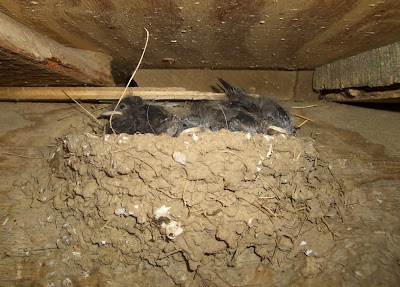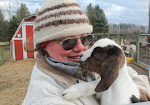
What does it truly mean to support local farmers? Meet the Edenbos. They grow chemical-free vegetables on a plot of land halfway between Mount Holly Springs and Boiling Springs. The are graduates of Dickinson College. They have a CSA and sell at the Carlisle Central Farmers Market. With the explosive growth of farmers markets and the push to 'buy locally', eaters need to go a step further and ASK where and how their foods are produced.
Notice the watermelon on the right. How many farmers in Cumberland County have ripe watermelon? How many miles did that watermelon have to travel? Was it grown without pesticides, herbicides, fungicides and insecticides? Who picked it? Where they paid a living wage? Was it even grown in this country? If you are dedicated to supporting local agriculture, you should be asking these questions and using some common sense about what is in season or is capable of being grown in the northeast region.

You can be assured that the couple in the top image are the same folks who tilled the soil, planted the seeds, nurtured the plants and harvested the product.
That's what local agriculture is all about!
 There has been lots of avian action at the farm of late--both wild and domesticated. The barn swallows who have been nesting in Bango's stall for several years now have once again returned to raise their young. While most horse people I know knock down the nests because the birds occasionally poop on their horses, we know that swallows are bug-eaters. What a few spots of poop here & there as opposed to pesky bugs.
There has been lots of avian action at the farm of late--both wild and domesticated. The barn swallows who have been nesting in Bango's stall for several years now have once again returned to raise their young. While most horse people I know knock down the nests because the birds occasionally poop on their horses, we know that swallows are bug-eaters. What a few spots of poop here & there as opposed to pesky bugs.  The turkey poults are really beginning to feather out. Nearly all their down is gone. Another week and we'll start turning off the brood lights during the day. This has been an extremely hardy batch and we've yet to lose any birds or notice any leg problems.
The turkey poults are really beginning to feather out. Nearly all their down is gone. Another week and we'll start turning off the brood lights during the day. This has been an extremely hardy batch and we've yet to lose any birds or notice any leg problems. Fortunately for the birds, our latest furry additions are still too young to actively hunt. Ralph is really fed up with the mouse population explosion and is taking no chances. He brought home more kitties. Officially, there are six in the barn, but I could only find five. We're making it a point to handle them daily so it's not a total nightmare when the time comes to vaccinate and spay them. We believe in being responsible animal owners, regardless of whether they are pets, livestock or working animals. Plus, from experience I've learned that a well-fed, spayed female cat is a merciless killer who will hunt for fun which is exactly what we need.
Fortunately for the birds, our latest furry additions are still too young to actively hunt. Ralph is really fed up with the mouse population explosion and is taking no chances. He brought home more kitties. Officially, there are six in the barn, but I could only find five. We're making it a point to handle them daily so it's not a total nightmare when the time comes to vaccinate and spay them. We believe in being responsible animal owners, regardless of whether they are pets, livestock or working animals. Plus, from experience I've learned that a well-fed, spayed female cat is a merciless killer who will hunt for fun which is exactly what we need.




































